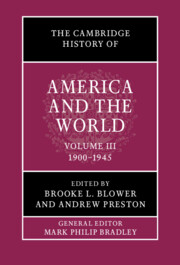Book contents
- The Cambridge History of America and the World
- The Cambridge History of America and the World
- The Cambridge History of America and the World
- Copyright page
- Contents
- Figures
- Maps
- Contributors to Volume III
- General Introduction: What is America and the World?
- Introduction to Volume III
- Part I American Power in the Modern Era
- Part II Competing Perspectives
- Part III The Perils of Interdependence
- 21 Borders and Migrants
- 22 Economic Catastrophes
- 23 Corporate Imperialism and the World of Goods
- 24 The Body Politics of US Imperial Power
- 25 Agriculture and Biodiversity
- 26 Worlds of International Development
- 27 Preserving Peace and Neutrality
- 28 The American Way in World War II
- 29 The Republic of Science and the Atomic Bomb
- 30 Visions of One World
- Index
30 - Visions of One World
from Part III - The Perils of Interdependence
Published online by Cambridge University Press: 12 November 2021
- The Cambridge History of America and the World
- The Cambridge History of America and the World
- The Cambridge History of America and the World
- Copyright page
- Contents
- Figures
- Maps
- Contributors to Volume III
- General Introduction: What is America and the World?
- Introduction to Volume III
- Part I American Power in the Modern Era
- Part II Competing Perspectives
- Part III The Perils of Interdependence
- 21 Borders and Migrants
- 22 Economic Catastrophes
- 23 Corporate Imperialism and the World of Goods
- 24 The Body Politics of US Imperial Power
- 25 Agriculture and Biodiversity
- 26 Worlds of International Development
- 27 Preserving Peace and Neutrality
- 28 The American Way in World War II
- 29 The Republic of Science and the Atomic Bomb
- 30 Visions of One World
- Index
Summary
On August 26, 1942, Wendell L. Willkie, who had been Franklin D. Roosevelt’s Republican opponent in the 1940 presidential election, took off from Mitchell Field on Long Island in a converted B-24 four-engine Liberator bomber. The bomber, called the “Gulliver” and flown by a crew of US Army officers, took Willkie on an extraordinary forty-nine day, 31,000-mile tour around a world engulfed in war. Not only did he circle the globe but, as Willkie made a point of noting after he landed back in Minneapolis, Minnesota, on October 14, for the bulk of his journey he flew around the equator, making numerous stops in South America, Africa, the Middle East, and Asia and looping back home through Siberia and over the Arctic Ocean (Map 30.1). En route, he toured Cairo, Egypt, and made a trip to El Alamein in the country’s Western Desert to confer with the Allied commander there, General Bernard “Monty” Montgomery, just as the Allied forces had stopped the German advance in North Africa and were planning for the final of defeat of their forces there. In Beirut, Lebanon, Willkie met with the exiled leader of the Free French, General Charles de Gaulle, in his villa in the city. In Jerusalem he received both Jewish and Arab representatives and contemplated the conflict between them, wondering presciently whether “the only solution to this tangled problem must be as drastic as Solomon’s.”1
- Type
- Chapter
- Information
- The Cambridge History of America and the World , pp. 702 - 722Publisher: Cambridge University PressPrint publication year: 2022

